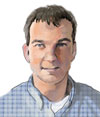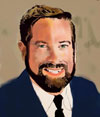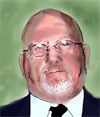November 23, 2007

A Primer on the Stem Cell Breakthrough
1. Remind me what all the hubbub surrounding stem cells is again.
Theoretically, illnesses caused by damaged or destroyed cells can be cured, if replacement cells can be created. Stem cells are a promising source of replacement cells.
2. So why don’t we use already cell therapies, wherever new cells would help?
Finding replacements is not easy. You can’t just drop any ol’ cell into a damaged area of the human body and expect it to take up the required function. Using the right cell for the right problem is necessary.
3. And stem cells are the answer, because…
They can be used to create any specialized type of cell.
Every cell in the body, literally within its DNA, contains all of the information necessary to produce every kind of tissue; heart, brain, nerve, bone, etc. that makes the body up. Given that we humans start out as a small set of cells (ultimately just a single cell), our cells at earliest stage of life must be flexible enough to use DNA information to produce any kind of tissue.
If doctors and scientists can find a source of these flexible cells -- stem cells -- and learn how to manipulate their growth, they may be able to create specialized cells useful in many therapies.
4. So let me rephrase question 2. Why don’t we already use cell therapies, wherever new cells created from stem cells would help?
Let me rephrase answer 2. Finding stem cells to make into replacements is not easy.
Until now, the primary source of stem cells fully capable of becoming any kind of tissue has been embryos, but acquiring embryonic stem cells requires destroying an embryo. This raises obvious ethical concerns.
And even if embryonic stem cells can be turned in to the appropriate cells for a cure, they cannot be readily transplanted into a sick patient, because of the body’s natural rejection of tissues that come from a foreign body.
5. What's the big breakthrough everyone is talking about?
Scientists announced a truly amazing discovery last week: the process of a stem cell turning into a specific tissue cell is apparently not as one-way as had been widely assumed. It is possible to take regular cells from an adult human and turn them back into stem cells. The Washington Post has provided a pretty good summary…
[Dr. Shinya Yamanaka’s team at Kyoto University] identified four genes in mouse skin cells that, when operating at high levels together, can turn countless other genes on and off in just the right pattern to make skin cells almost indistinguishable from embryonic stem cells….Dr. James Thomson of the University of Wisconsin-Madison discovered a similar process around the same time.Because the rejuvenated cells did not come from embryos and behave slightly differently from embryonic stem cells, Yamanaka named them "induced pluripotent stem cells," or "ips" cells (pluripotent means "able to become virtually every kind of").
He immediately tried the same technique on human skin cells….He coaxed the ips cells to become nerve cells, heart cells that beat in the dish, and other major cell types. And he showed that they were exact genetic matches to the skin cells they came from, suggesting that tissues or organs grown from them could be transplanted into the donor of the skin cells and not be rejected.
6. How is the transformation done?
Literally, by reprogramming DNA….
Yamanaka put copies of [the] four genes into retroviruses, Trojan-horse-like viruses that insert their genetic payloads into the DNA of cells they infect. Once infected, the skin cells took on virtually all the characteristics of embryonic ones….At the same time, Thomson, Junying Yu and colleagues were racing ahead. Working from an initial list of 14 genes that seemed to make human cells embryonic, they gradually narrowed their recipe to just four genes, too….
His cells passed the same tests as Yamanaka's, though in his final recipe, two of the genes he used were different.
"Apparently there are various ways to get to Rome," said Rudolf Jaenisch, a stem cell researcher at the Whitehead Institute for Biomedical Research in Cambridge, Mass. "We don't have to do it like the egg. We can do it differently."
7. In politically charged science debates, the claims sometimes get ahead of the reality. Any reason to be skeptical here?
Well, James Thomson is the same scientist who discovered embryonic stem cells about a decade ago, so if he thinks this is for real, there is obviously something to that.
Dr. Yamanaka and Dr. Thomson haven’t quite made the claim that they've produced stem cells, but cells that are very close to stem cells. Some more observation and experimentation is needed before it can be claimed that they are 100% true stem cells.
The process of creating the stem cells involves certain cancer risks, but because there are mulitple ways to induce the transformation into a stem cell, the researchers in the field seem confident that this problem will be worked around. But I'll repeat the warning in the question -- in politically charged science debates, the claims sometimes get ahead of the reality
With certain diseases that originate at the genetic level, generating your own stem cells will not be a solution, because the stem cells will contain the same defects causing the illness, so solving the rejection problem and allowing cells from another person to be transplanted will continue to be investigated.
8. For the more technically minded, can you be any more specific about any of this?
Well, I suppose I could re-print the abstract from Dr. Thomson et. al’s article appearing in the journal Science…
Somatic cell nuclear transfer allows trans-acting factors present in the mammalian oocyte to reprogram somatic cell nuclei to an undifferentiated state. Here we show that four factors (OCT4, SOX2, NANOG, and LIN28) are sufficient to reprogram human somatic cells to pluripotent stem cells that exhibit the essential characteristics of embryonic stem cells. These human induced pluripotent stem cells have normal karyotypes, express telomerase activity, express cell surface markers and genes that characterize human ES cells, and maintain the developmental potential to differentiate into advanced derivatives of all three primary germ layers. Such human induced pluripotent cell lines should be useful in the production of new disease models and in drug development as well as application in transplantation medicine once technical limitations (for example, mutation through viral integration) are eliminated.Er, that makes it all clear, right?



 About Community Crier
About Community Crier

 About Engaged Citizen
About Engaged Citizen Administrator
Administrator




Whew, two scientists from two different labs got almost the same result. This should reduce the chances that this is a fraudulent discovery, like the South Korean cloning scandal in 2005.
Good post, Andrew.
Posted by: Monique at November 23, 2007 3:21 PMhttp://news.bbc.co.uk/2/hi/asia-pacific/4554422.stm